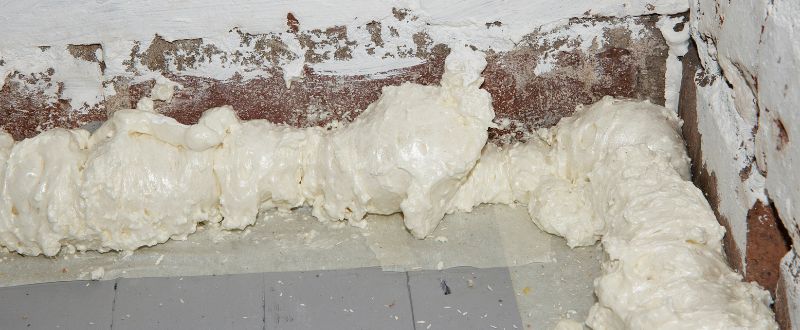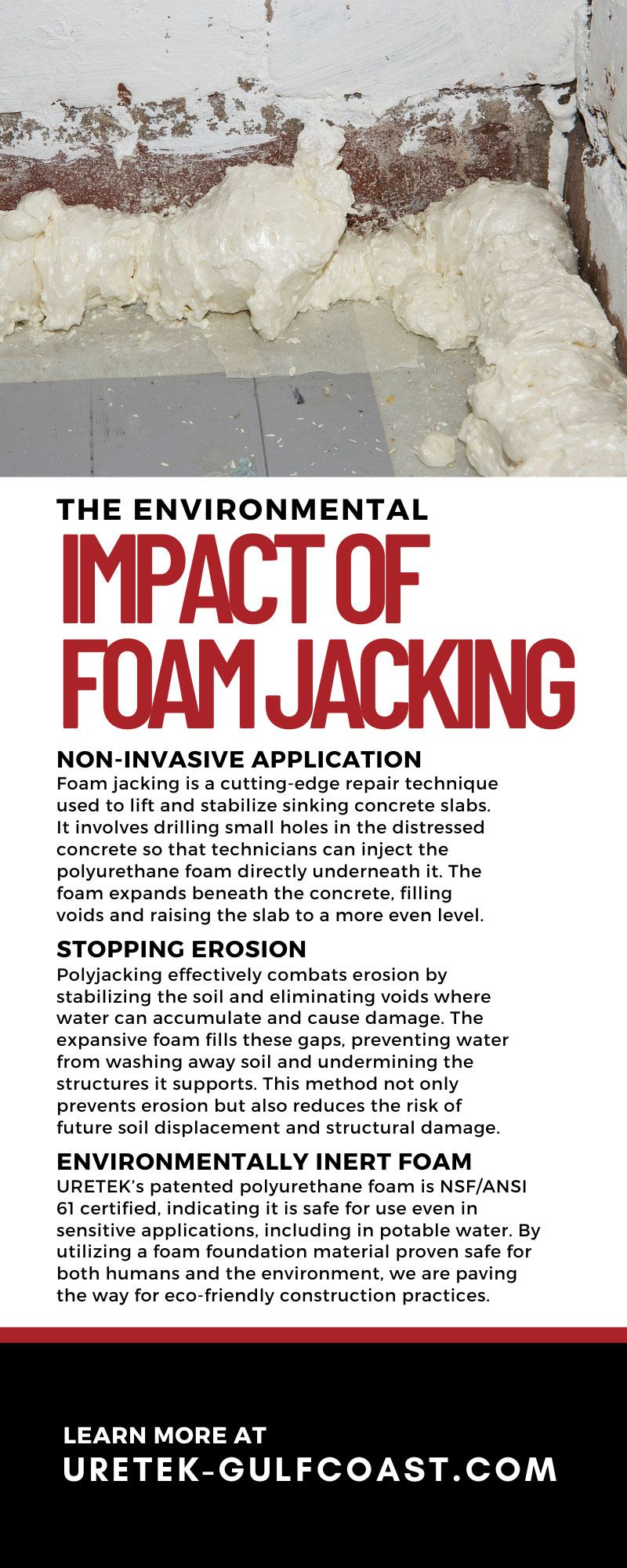Foam jacking, also known as polyjacking, quickly and effectively repairs sunken and uneven foundations and other concrete structures. Property owners can use this advanced technique to correct issues in residential driveways, commercial building floors, municipal sidewalks, and even airport runways, among other applications. The process reinstates structural integrity and extends the lifespan of the concrete, making it a preferred choice for both preventative maintenance and urgent repairs.
Polyjacking saves time and money, and the repairs are long lasting. Furthermore, foam jacking—and especially URETEK’s patented polyurethane foam—minimizes the environmental effect of concrete repair. Learn about the foam jacking process and characteristics of expanding polyurethane foam to understand the environmental impact of foam jacking.
Non-Invasive Application
Foam jacking is a cutting-edge repair technique used to lift and stabilize sinking concrete slabs. It involves drilling small holes in the distressed concrete so that technicians can inject the polyurethane foam directly underneath it. The foam expands beneath the concrete, filling voids and raising the slab to a more even level.
This method not only restores the concrete surface to its proper elevation but also offers a durable solution by strengthening the base material. Unlike traditional methods, foam jacking causes minimal disruption to the surrounding area, making it a preferred choice for both residential and commercial applications. Additionally, the foam cures to 90 percent strength in 15 minutes, so people can use the area as usual shortly after application.
The Benefits of Injection Over Excavation
Traditional repair techniques may require excavation, but polyjacking only requires technicians to drill holes about the size of a penny into the slab. Choosing not to excavate for foundation repairs has substantial environmental benefits. Injection minimizes disruption to the surrounding environment, preserving the natural habitat of flora and fauna in the vicinity. Additionally, URETEK Deep Injection® (UDI) reduces the carbon footprint associated with heavy machinery use and limits waste generation.
Stopping Erosion
Polyjacking effectively combats erosion by stabilizing the soil and eliminating voids where water can accumulate and cause damage. The expansive foam fills these gaps, preventing water from washing away soil and undermining the structures it supports. This method not only prevents erosion but also reduces the risk of future soil displacement and structural damage.
Halting erosion has vast environmental benefits. It preserves the natural landscape, prevents sediment from contaminating waterways, and maintains the habitat for local flora and fauna. By ensuring that the ground remains intact, polyjacking plays a crucial role in sustaining the health of the ecosystem, making it a preferred choice for environmentally conscious projects.
Environmentally Inert Foam
URETEK uses environmentally inert foam in polyurethane injection foundation repair. This characteristic means that the material does not react chemically with surrounding soil or water, nor does it degrade into harmful substances. This characteristic ensures that the repair process does not contribute to environmental pollution or harm local ecosystems.
URETEK’s patented polyurethane foam is NSF/ANSI 61 certified, indicating it is safe for use even in sensitive applications, including in potable water. By utilizing a foam foundation material proven safe for both humans and the environment, we are paving the way for eco-friendly construction practices.
Problems With Reactive Materials
Materials that react chemically with the environment pose several risks. These reactions can lead to the contamination of soil and water sources, endangering wildlife and potentially affecting human health by infiltrating the food chain. Furthermore, such interactions can compromise the structural integrity of the repair over time, necessitating further, more invasive repair work and exacerbating environmental impact.
Hydro-Insensitive
URETEK’s foam is also hydro-insensitive, meaning it remains unaffected by water. This property makes it an ideal choice for repairs in areas prone to moisture, such as near bodies of water or in regions with high humidity levels. Unlike typical materials that can absorb water, leading to expansion, contraction, or degradation, hydro-insensitive foam maintains its integrity, ensuring long-lasting repairs.
The environmental benefits of using hydro-insensitive foam are significant. Firstly, hydro-sensitive materials can damage water supplies by leaching chemicals. Secondly, foam that maintains its structural integrity in wet conditions reduces the need for future repairs, cutting down on resource consumption and minimizing the environmental footprint of maintenance activities. This makes hydro-insensitive foam a sustainable choice for foundation and concrete repairs, aligning with efforts to protect and preserve natural resources.
Structural-Grade and Durable
Closed-cell foam utilized in the foam jacking process is dense, rigid, and durable. This characteristic makes it a structural grade material capable of improving the concrete’s stability. The closed-cell structure also provides excellent water resistance, preventing moisture ingress, which helps maintain the integrity of the repairs over time.
The density and rigidity of closed-cell foam contribute significantly to its environmental benefits. Its durability reduces the need for frequent maintenance or replacement and, consequently, lessens the environmental impact associated with repair activities. Furthermore, its resistance to water and other environmental factors means that it does not contribute to pollution or degradation of the surrounding ecosystem.
Comparisons With Other Methods
Comparing polyjacking to mudjacking and full slab replacement further emphasizes the minimal environmental impact of foam jacking. Understanding these differences allows property owners to make informed decisions that align with their priorities, whether that be minimizing ecological footprints, ensuring durability, or managing repair costs.
Mudjacking
Mudjacking involves lifting and stabilizing sunken concrete slabs by injecting a mixture of water, soil, sand, and cement beneath the slab. This process requires holes larger than those used in foam jacking. Mudjacking also has a higher likelihood of resettlement over time because the material’s heavier weight compresses the underlying soil. The impermanence of a mudjacking repair means more repairs in the future, requiring more resources.
Slab Replacement
Full slab replacement is an extensive method wherein contractors remove and replace damaged concrete. This process may entail partial slab, full slab, or multiple slab replacement. This method involves significant excavation work, causing considerable disruption to the surrounding landscape and ecosystems. Unlike foam jacking, full slab replacement is labor-intensive and generates a considerable amount of waste material, including the broken concrete slab and the excess new concrete used in the replacement.
The demolition and removal process contributes to air and noise pollution, while the production and transportation of new concrete significantly increases the carbon footprint of the project. Furthermore, the disposal of the old concrete slab contributes to landfill waste.
Foam jacking offers a viable and environmentally friendly alternative for addressing concrete and foundation repairs. By minimizing physical disruption to the surrounding area, reducing the need for future repairs, and using environmentally inert and hydro-insensitive foam, this technique protects the environment. Invest in this durable and effective repair method to minimize environmental harm and restore concrete’s stability.


